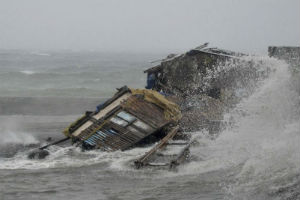Fundraising by nonprofits responding to a massive typhoon that leveled parts of the Philippines surpassed $44 million in the first few days after the disaster. Typhoon Haiyan struck Nov. 8, leveling cities such as Tacloban, more than 500 miles south of the nation’s capital, Manila.
Preliminary estimates from 13 charities surveyed by The NonProfit Times confirmed that at least $43.9 million has been raised, led as usual by the American Red Cross, which had raised $11 million as of this past Wednesday. That aggregate total, however, is far from complete. While many organizations responding to the inquiry provided figures as of Thursday, several large relief organizations did not have initial estimates available. At least nine organizations reported more than $1 million in contributions.
Médicins Sans Frontières / Doctors Without Borders (MSF) has raised $11.24 million globally, of which $2.5 million was contributed in the United States, as of Friday morning. U.S. Fund for UNICEF had raised nearly $5.2 million, with an appeal to raise $34 million for its response to the disaster, and Baltimore, Md.-based Catholic Relief Services (CRS) has raised $4.8 million.
American Red Cross is featured prominently this week on Facebook, with a $10 solicitation at the top of a user’s news feed. The $11 million reportedly raised so far does not include any funds raised through Facebook but the totals should be updated this weekend with a breakdown, according to a spokesman.
If recent global disasters are any indication, charitable contributions toward relief efforts should begin to spike a week after the event and continue to ascend sharply for the next month. According to the Indiana University Lilly Family School of Philanthropy, contributions in response to an earthquake that struck Japan in March 2011 reached $92 million after about a week, and $160 million after two weeks. In response to the Haiti earthquake in 2010, contributions reached $317 million after a week and $554 million after two weeks.
According to the Lilly School, charitable giving has eclipsed $1 billion in response to four disasters:
- $4.2 billion, Hurricane Katrina (2005)
- $2.6 billion, September 11 terrorist attacks (2001)
- $1.8 billion, Indonesian tsunami (2004)
- $1.5 billion, Haiti earthquake (2010)
There are hundreds of people confirmed dead as a result of Typhoon Haiyan while officials have scaled back initial estimates of 10,000 dead to more like 2,500, according to CNN. The typhoon has affected more than 10 million people, according to recent estimates, and displaced hundreds of thousands. World Vision has estimated that the top 10 natural disasters so far this year (through July) have affected almost 8.5 million people. The Federal Way, Wash.-based charity is seeking to raise $20 million for relief efforts. Salesian Missions in New Rochelle, N.Y., estimates it needs to raise more than $5 million for initial relief efforts, specifically for food and water, as well as transportation and distribution costs, according to a spokesperson.
Organizations are still working to get supplies to affected regions that are difficult to reach because of infrastructure breakdowns, with power outages, airports shutdown and roads blocked by debris.
U.S. Fund for UNICEF has purchased 10,000 water kits and 10,500 family water kits locally as well as water tablets for 6.3 million liters of water. Nearly 2,000 tarps have been delivered and 72 tents that can be used for schools and safe spaces. The organization committed $3 million from its operational reserve and another $10 million over the next three months. American Red Cross has committed an initial $6 million to the typhoon response.
UNICEF has partnered with New York Road Runners (NYRR) to aid children impacted by Haiyan. NYRR will match the first $26,200 in donations by members of the running community across the nation. Through a dedicated “Run for the Philippines” page on Crowdrise, individuals can donate directly and set up a fundraising around their next run.
Crowdfunding, social media and text-to-give all have taken on more prominence in the aftermath of recent disasters.
Social media sites like Twitter and Facebook still were growing only a few years ago. “This time around, a lot of the tools are the same but the scale is totally different; more people are using Twitter, and more supporters are using Twitter and Facebook,” said Megan Weintraub, new media manager at Boston, Mass.-based Oxfam America. In previous disasters, the organization might tell supporters to follow it on Twitter for the latest updates, expecting people to first visit its website. Today, however, Oxfam America has thousands of followers via Twitter and Facebook that it can use to immediately provide information to all those supporters.
What the Indonesian tsunami in 2004 did for online giving, the 2010 Haiti earthquake did for mobile text donations, getting the general public more comfortable — and active — with the giving channel. Charities raising money with The mGive Foundation generated almost $43 million in text donations for Haiti relief. Last year, about $8.7 million was raised by text for Hurricane Sandy and $4.6 million in response to the Japan earthquake in 2011, according to mGive.
More than two dozen charities are raising money through The mGive Foundation and the Mobile Giving Foundation.
Text donations are the modern-day version of bringing people together like a bucket brigade, allowing mobile users to help neighbors down the street or around the world in the Philippines, according to Jenifer Snyder, executive director of The mGive Foundation.
“Texting a donation is a handshake into a nonprofit organization. Savvy nonprofit leaders use the opportunity of communicating with new donors by building rapport through text. Later they ask for additional contributions of time, money and resources through text – not during disaster but after the relationship has been well established,” she said.
“We’ve seen time and time again, nonprofit organizations that use text, acquire a new set of donors who have never considered contributing through any other channel. We’re seeing that now with nonprofits collecting donations for Philippines relief,” Snyder said.
